In The Great Wave off Kanagawa, by Hokusai, three fishing boats float in the trough of a gigantic rogue wave that stretches claw-like whitecaps over them. Fishermen cling to oars, desperate to stay aboard when the water crashes upon them. Mount Fuji is visible in the distance, snow covered, like an additional wave, completing the tableau of dominating natural barriers.
Dances
“Moss” is a meditation on the passage of time. It depicts a field of grass being gradually overgrown by moss, green blades tightly interwoven with moss stems, until they cannot be told apart. Our dance also references mortality, mourners at a funeral waiting their turn to be part of the soil, and the consolations of companionship.
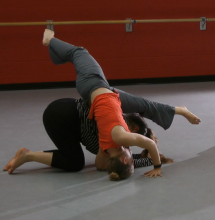
“Crane” is based on the Japanese myth “Tsuru no Ongaeshi,” about a crane, freed from a trap by a hunter, who becomes a woman in order to live with him. Her spell is broken when the hunter breaks his vow and looks at her while she is plucking her feathers.
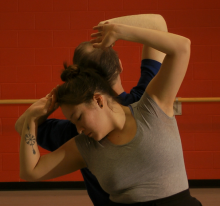
Merce Cunningham, choreographer, and John Cage, composer, were two of the most influential artist/collaborators of the 20th century. Less well known, because they kept it that way, the two were also life partners. This is the central tension that Malcolm Shute explores in a dance in their honor: for two men so often in the public eye, they kept their private lives scrupulously private.
"Shades" is a modern retelling of "The Kingdom of the Shades" section of the ballet La Bayadere.
Rumplestiltskin unpacks the myth to depict an estranged father meeting his unwelcome firstborn son.
"Swans" (2015) is our modern retelling of Swan Lake. To deconstruct this tragic ballet about a prince who cannot decide between a white swan and a black swan, we created four swans for him to vacillate over: white, black, red, and gray. Each swan has a different attitude toward Siegfried, played by the incomparable Alexander Short, including hostile, seductive, dependent, and indifferent. In duets, they alternately confront him, fly upon his shoulder, lean gently into his arms, or push him away.
Human Landscape Dance's 2015 version of "Coppelia" addresses gender stereotypes in the original ballet.
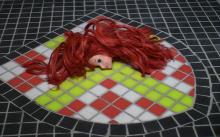
"Alexander Short and Shute roll effortlessly together as the roiling, muddy currents of the underworld’s River Styx. Becoming Hades, Shute rests alongside Eliza Talbott (Persephone) on Short’s back. Shute presses and prods Talbott as she struggles away from his grasp, until his hand reaches her mouth to feed her the pomegranate seed that will lock Persephone into his world.
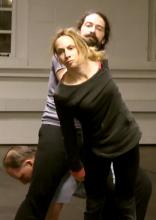
Cinderella premiered on Saturday January 4, 2014, at 8pm in the Modern Moves Festival at the Atlas Performing Arts Center, in Washington DC, 1333 H St NE.
"In a separate piece, Amanda Abrams was brilliant as the long-suffering Penelope weaving away as she waited years for her husband, Odysseus, to return. For most of “Penelope and Odysseus/Waiting,” Abrams remained in a chair, almost magically defying the limits of scale and reach that this imposed. Her arms spoke volumes. In her hands, repetition became a powerful force.

"Shute’s final tour de force was the disembodied head of Medusa, performed by Heather Doyle, using eyes, eyebrows and soundlessly moving mouth to convey wonderment at all that she no longer had to bother with now, like painting her toenails.
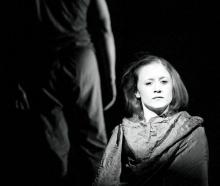
"Human Landscape Dance is grounded in contact improvisation. Shute put this to good use in“Aurora’s Dream,” which revealed what Sleeping Beauty was dreaming about all those years. The dream looked a cross between Disneyland and Hieronymus Bosch. The prince was a deviant for having crept into her bedroom.
Human Landscape Dance premiered "Icarus and Daedalus" at the Kennedy Center Millennium Stage on Wednesday March 23, 2011. Watch a video of this performance.
Human Landscape Dance premiered "January Night," in Philadelphia at the Painted Bride Art Center on May 29, 30 2010. The Philadelphia/Washington DC Exchange was a shared concert with Anne-Marie Mulgrew and Dancers Co, who premiered "Burn."
The performers in Human Landscape Dance's "Closet Dances" are cramped. Each of the four dances depicts people stuck within the narrow confines of a walk-in closet. This closeness intensifies their relationships.
Closet Dances was performed at the Kennedy Center Millennium Stage on Wednesday March 23, 2011. Watch a video of this performance.
"Coming Unstuck" (2007) relates the challenges of new parents to cope with a sleepless child. Rocking the baby becomes a vibration, passed from one dancer to another, which is interrupted by heaving sobs.
“Leaving Home” takes place on grass, this vestige of nature in the city. The dancers, encircled by a fabric egg, evoke images of birth on the ripe green leaves. They move blindly at first, tracing the edges of their enclosure and taking stock of each other. As they wrestle with how or if to leave, you are encouraged to reflect on your own experience of home and your own attitudes toward change.
